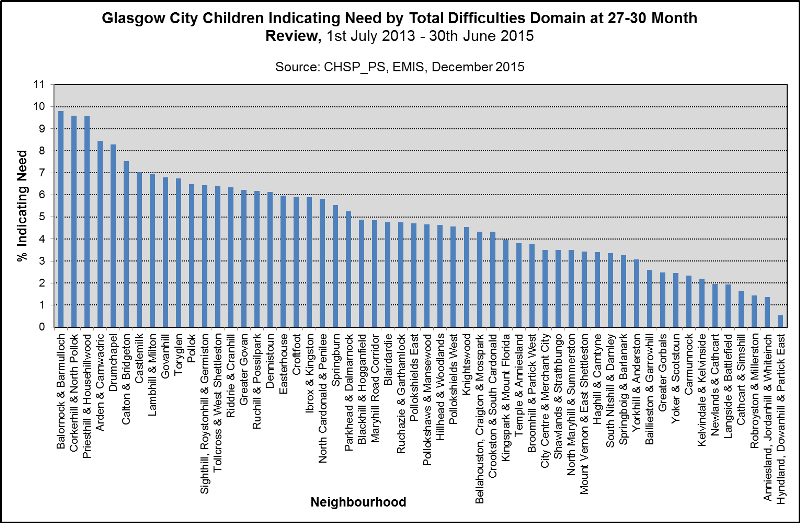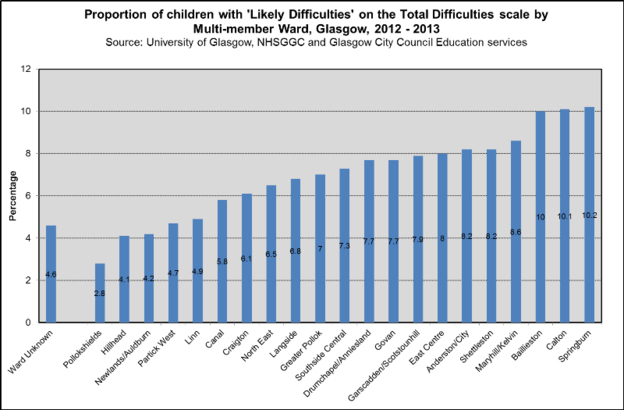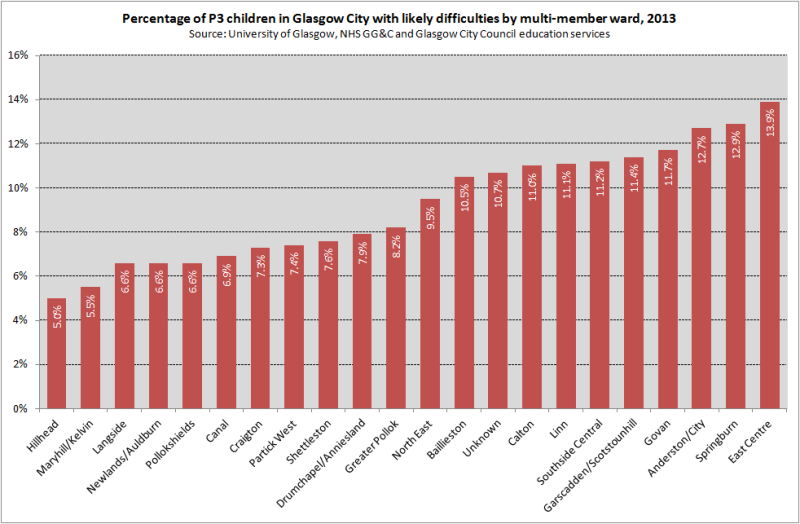Neighbourhood and ward
Glasgow City children indicating need by Total Difficulties domain at 27-30 month review 1st July 2013 - 30th June 2015
 There were large variations in the proportions of children with likely difficulties living in different neighbourhoods of the city, ranging from less than 2% in Nitshill and Darnley to 13% in Balornock and Barmulloch.
There were large variations in the proportions of children with likely difficulties living in different neighbourhoods of the city, ranging from less than 2% in Nitshill and Darnley to 13% in Balornock and Barmulloch.
Proportion of pre-school children in the Likely Difficulties range of the Total Difficulties scale by Ward
 There were large variations in the proportions of children with likely difficulties living in different areas of the city. The areas with the highest proportions of children with difficulties were Springburn, Calton and Ballieston, whilst those with the lowest proportions of children with difficulties were Pollokshields, Hillhead, and Newlands/Auldburn.
There were large variations in the proportions of children with likely difficulties living in different areas of the city. The areas with the highest proportions of children with difficulties were Springburn, Calton and Ballieston, whilst those with the lowest proportions of children with difficulties were Pollokshields, Hillhead, and Newlands/Auldburn.
Proportion of P3 children in the Likely Difficulties range of the Total Difficulties scale by Ward
 Levels of difficulties also varied by the ward in which the children lived. P3 children in Hillhead and Maryhill/Kelvin had the lowest levels of overall difficulties, with 5% and 5.5%, respectively, having likely difficulties overall in these areas. East centre had the highest level of difficulties, with 13.9% of children in this ward having likely difficulties, closely followed by Springburn (12.9%) and Anderston/City (12.7%).
Levels of difficulties also varied by the ward in which the children lived. P3 children in Hillhead and Maryhill/Kelvin had the lowest levels of overall difficulties, with 5% and 5.5%, respectively, having likely difficulties overall in these areas. East centre had the highest level of difficulties, with 13.9% of children in this ward having likely difficulties, closely followed by Springburn (12.9%) and Anderston/City (12.7%).
Notes
The SDQ is a brief behavioural screening questionnaire for children. It covers five areas: Conduct Problems, Hyperactivity/inattention, Peer Relationship Problems, Emotional Symptoms and Pro-social Behaviours. The first four of these are rated negatively (that is, they pick up difficulties in children). These can be added together to give a Total Difficulties score, which shows an indication of overall difficulties that the child is experiencing. The final area, Pro-social Behaviours, is a positively scored scale, so it shows things the child does e.g. ‘is helpful if someone is hurt or upset’. The Total Difficulties score and the sub-scale scores can be split into groups which indicate whether a child has no difficulties, possible difficulties or likely difficulties. A global SDQ score of over 17 indicates a behavioural concern. If needs are identified via the SDQ, a set of impact questions is also completed in partnership with the parent or carer to gain a deeper insight into the impact of the current behaviour on the family.
